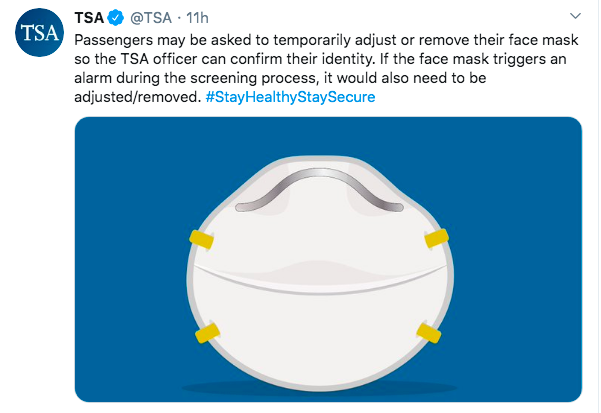People are slowly returning to air travel. While the current volume is about 1/3 of what it was a year ago, that’s saying something since we’re still smack dab in the middle of an uncontrolled pandemic. The airlines are doing their part to make passengers feel safe; whether it’s by blocking middle seats or touting their super circulated, filtered air and electrostatic sterilization spray they’re using on surfaces.
Even if you feel safe getting on a plane, you still have to go through the airport to get to your gate. That includes going through the TSA checkpoint. While airports follow local requirements about mask-wearing, there’s still no federal government mandate to wear a mask at the airport. The TSA also suggests wearing a mask throughout your travel experience but does not require them while going through the checkpoint. If you choose to wear a mask, which you should, the TSA may ask you to adjust or even remove it for identification.

The TSA can also require you to remove your mask if it triggers an alarm during the screening process. I’d imagine that would require putting it through the x-ray.
Needing to adjust or remove your mask might make some passengers uncomfortable. That’s understandable, particularly because TSA checkpoint agents are still contracting coronavirus.
The TSA has a chart on its website showing the number of confirmed cases in TSA employees and breaks out the number of screening agents and the last work date of the most recent screening officer confirmed case. Looking at the numbers, it’s almost a direct correlation between the cases within TSA workers and the general population. Airports in Florida, Texas and New York have seen the largest number of cases. Some airports, such as Grand Forks, ND, Gulfport, MS and Dayton, OH have just seen their first cases in the last 2 weeks. These are the same locations that avoided the original spike of cases nationwide but are now seeing the virus take hold.
Who knows what risk you’re taking by having to take off your mask when going through the checkpoint? TSA employees are required to wear masks so you have that going for you. In fact, you might be more of a risk to the TSA screener than they are to you.
#stayhealthy #staysafe #washyourhands #wearamask
Want to comment on this post? Great! Read this first to help ensure it gets approved.
Like this post? Please share it! We have plenty more just like it and would love it if you decided to hang around and get emailed notifications of when we post. Or maybe you’d like to join our Facebook group – we have 15,000+ members and we talk and ask questions about travel (including Disney parks), creative ways to earn frequent flyer miles and hotel points, how to save money on or for your trips, get access to travel articles you may not see otherwise, etc. Whether you’ve read our posts before or this is the first time you’re stopping by, we’re really glad you’re here and hope you come back to visit again!
This post first appeared on Your Mileage May Vary

4 comments
I have flown several times in the last few months and have adjusted my mask for the TSA agent for a total of about 10 seconds each time I pass through security. Are you implying that we are at risk of getting COVID from a TSA agent sitting 4 feet away with plexiglass between us and the mask pulled down for 10 seconds?
I think it’s ironic that Just as facial recognition was really taking hold in airline travel then we have the mask situation kick in. TSA agents should be wearing masks if in close contact with the public. If they are behind glass I’d feel differently but most aren’t. I say this as an anti-mask person. They are in a position to spread viruses to many people even in a typical flu year.
Just say no and stay home and vote.
Good point in the blog – even if masks were made mandatory nationally, you will likely have to remove your mask at a TSA or border control checkpoint bottleneck where the public is funneled into a potential killing zone (no mask+no social distancing+exposure to a mixture of general public). Risk will be elevated. This will greatly depress, or eliminate flight demand, among the elevated risk population which includes those with preexisting conditions, obesity or advanced age). It will also greatly depress or eliminate cruise demand, as a high percentage of cruisers fly to ports as well as fall in the elevated risk population.